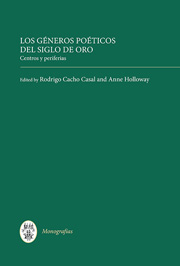Book contents
- Frontmatter
- Dedication
- Contents
- Índice de ilustrationes
- Índice de colaboradores
- Introducción: Géneros, centros, periferias
- I DEL CENTRO A LA PERIFERIA: GÉNEROS Y CONTRAGÉNEROS
- II AGUDEZA, RETÓRICA Y EMBLEMÁTICA
- III GÓNGORA Y SU ESTELA
- IV POESÍA COLONIAL: EL NUEVO CENTRO
- 11 La glorificación de la periferia del Nuevo Mundo: representaciones de Cabeza de Vaca en La Argentina (1602) de Martín del Barco Centenera y otros textos fundacionales del Río del la Platao
- 12 Sujetos periféricos, diálogos parnasianos: la voz femenina y la epístola en la poesía colonial
- 13 La crucifixión como materia poética en la América colonial: Hernando Domínguez Camargo y su romance A la pasión de Cristo
- V LA POESÍA Y SUS MARCOS: MANUSCRITOS, ANTOLOGÍAS, MISCELÁNEAS
- Bibliografía
- Índice onomástico
12 - Sujetos periféricos, diálogos parnasianos: la voz femenina y la epístola en la poesía colonial
from IV - POESÍA COLONIAL: EL NUEVO CENTRO
Published online by Cambridge University Press: 05 September 2013
- Frontmatter
- Dedication
- Contents
- Índice de ilustrationes
- Índice de colaboradores
- Introducción: Géneros, centros, periferias
- I DEL CENTRO A LA PERIFERIA: GÉNEROS Y CONTRAGÉNEROS
- II AGUDEZA, RETÓRICA Y EMBLEMÁTICA
- III GÓNGORA Y SU ESTELA
- IV POESÍA COLONIAL: EL NUEVO CENTRO
- 11 La glorificación de la periferia del Nuevo Mundo: representaciones de Cabeza de Vaca en La Argentina (1602) de Martín del Barco Centenera y otros textos fundacionales del Río del la Platao
- 12 Sujetos periféricos, diálogos parnasianos: la voz femenina y la epístola en la poesía colonial
- 13 La crucifixión como materia poética en la América colonial: Hernando Domínguez Camargo y su romance A la pasión de Cristo
- V LA POESÍA Y SUS MARCOS: MANUSCRITOS, ANTOLOGÍAS, MISCELÁNEAS
- Bibliografía
- Índice onomástico
Summary
… queriendo de mi boca
hurtarme la canción, aún no nacida.
(Safo a Faón, Primera parte del Parnaso antártico, trad.
Diego Mexía, Sevilla, 1608)Los estudios más recientes sobre la escritura de mujeres de comienzos de la Edad Moderna se definen por una cierta permeabilidad crítica, donde la división tradicional entre literatura ibérica y colonial queda a menudo difuminada, tal como señala Kathleen Myers. A su vez, Mary Louis Pratt insiste en estas cuestiones y sugiere que los textos que intentan representar el encuentro entre dos culturas diferentes suelen, inevitablemente, mostrar una cierta inestabilidad a nivel genérico. Partiendo de estas aseveraciones, mi objetivo principal en este trabajo es explorar la formación y la recepción de la voz femenina, centrándome en poemas que han sido leídos como portadores de una subjetividad colonial femenina emergente. Para llevar a cabo este análisis será preciso también atribuir una función clave al legado de Las Heroidas de Ovidio; textos poéticos que son a la vez epístolas de anhelo amoroso e intensas representaciones de arte femenino. Mi estudio tendrá en cuenta tres voces femeninas, deslumbrantes todas ellas: las de las autoras conocidas como ‘Amarilis’ y ‘Clarinda’, así como la de la Safo ovidiana, en la traducción de Diego Mexía, y considerará su interacción con los autores masculinos que les han dado prominencia. En términos de género, estas voces tienen en común la epístola, ya que el texto de Clarinda sirve para introducir la traducción española de Las Heroidas.
- Type
- Chapter
- Information
- Los géneros poéticos del Siglo de OroCentros y periferias, pp. 233 - 252Publisher: Boydell & BrewerPrint publication year: 2013



